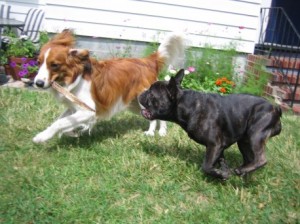The leader is the one in control of the resources. Some dogs need to be in control of everything. Others are totally passive. Most are somewhere in between. Either way, you can be sure your dog knows exactly who controls the resources.

Two Dogs Playfully Decide Who Will Control the Coveted Stick. Dog-to-Dog Behavior in Relation to Resource Control is Similar to Dog-Human.
What do I mean by resources? I mean the things that matter most to your dog. And every dog is different.
I took a survey of 1 million dogs, asking them which resources were most important to them, here’s what they said:
- Food
- Toys
- Resting Areas
- Water
- Territory
- Entrances/Exits
- Access to other dogs
- People (and their attention)
- Whatever all the other dogs want
(No, I did not really survey dogs. They can’t talk or write. But this is pretty close to what they would have said.)
Ok, so here’s the deal: If your dog doesn’t appreciate that you control the resources, he won’t see you as a leader. How does this happen?
Example 1 – The lowest level of leadership: You give everything away for free. Your dog gets so much attention, food, access to preferred resting areas, etc that he has absolutely no appreciation for any of it. He doesn’t believe you control anything. In fact, he thinks you are his slave. You have no expectation of good behavior from him before you give him anything, and therefore he doesn’t bother listening to a word you say.
(Unless the words are “Here shmoopy, have a marrow bone.”)
Example 2 – The Illusion of Leadership. You are eating a sandwich. You think you’re in control of it. But you’re not. Why? Because all your dog has to do is come over and perform a certain behavior that works every time. You’ll give up a piece of your meal, she’s certain. This could be begging, barking, nudging, jumping – whatever – your dog knows it works. If somehow it doesn’t work the first time, she escalates to a more obnoxious behavior (bark louder, nudge harder). Then you give in. She doesn’t dream for one moment that the item is yours. You’re just holding it for her.
Example 3 – Actual Leadership. You don’t share everything. Sometimes you keep certain things all to yourself. Like your bed. Or your meals. Sometimes you share, but sometimes you say NO. And when you say no, you stick with your decision. This gains you respect, teaches your dog patience. This builds frustration tolerance (don’t own a dog without it). Teaching your dog to accept limits and boundaries makes you a leader.
This doesn’t mean you can’t share your bed with your dog, of course you can. But if you ask your dog to get off, does he get off? If so – wonderful, he respects your control over this resting area. That’s a sign of your leadership. It’s tough to be a leader without control over your own bed. (!)
The Wrap: Please DO share generously with your dogs, but not everything, not all the time. And when you share, make it clear that it’s YOUR choice. Remember leaders initiate, followers react. Only share with a dog who is being polite. A great example is to have your dog lie down quietly while you prepare their food, then YOU release them to eat it once you place it on the floor. This shows that you control the resources and you initiate the decisions.






 Phone:
Phone: